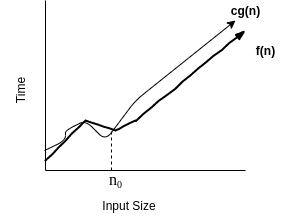Big-O Notation
Big-O notation
- Worst-case analysis.
- Upper bound of an algorithm.
- O(g(n)) - {f(n) : there exist constants c and n0 such that 0<=f(n)<=cg(n) for all n >= n0}
- It is commonly used to calculate time analysis of an algorithm, it will give us an upper bound limit which doesn't exceed any input size. You can clearly see in the below diagram after a particular size of the input (n0 ) after then the f(n) always lies in or below the c.g(n).
- Drop lower order term
- Drop constants
Let's understand the above rules in an example:-
int a = 1; // O(1) int b = 2; // O(1) int c = 3; // O(1) for (int i = 1; i <= n; i++) { // O(n + 1) for (int i1 = 1; i1 <= n; i1++) { // O(n +1) a = i*i1; // O(1) b = i*i1; // O(1) c = i*i1; // O(1) } } for (int i = 0; i < n; i++) { // O(n) a *= i; // O(1) b *= i; // O(1) } c = 0; // O(1)
- We are removing all the lower order terms from T(n) which will now become T(n) = 3n2 + 4.
- Now, we have to perform the final steps to get the time complexity which we need to drop the constants after applying the 2nd rule T(n) will become O(n2).
According to our time complexity analysis, the above algorithm will never go beyond the O(n2) for any growth rate of input size.
Here are few commonly used function names in Big-O.
| f(n) | Name | Example |
| 1 | Constant | Sum of Two number |
| log2n | Logarithmic | Binary Search |
| n | Linear | Kadane’s Algorithm |
| n*log2n | Log-Linear | Merge Sort |
| n2 | Quadratic | Bubble Sort |
| n3 | Cubic | Product of n*n matrix |
| 2n | Exponential | Fibonacci |


Comments
Post a Comment